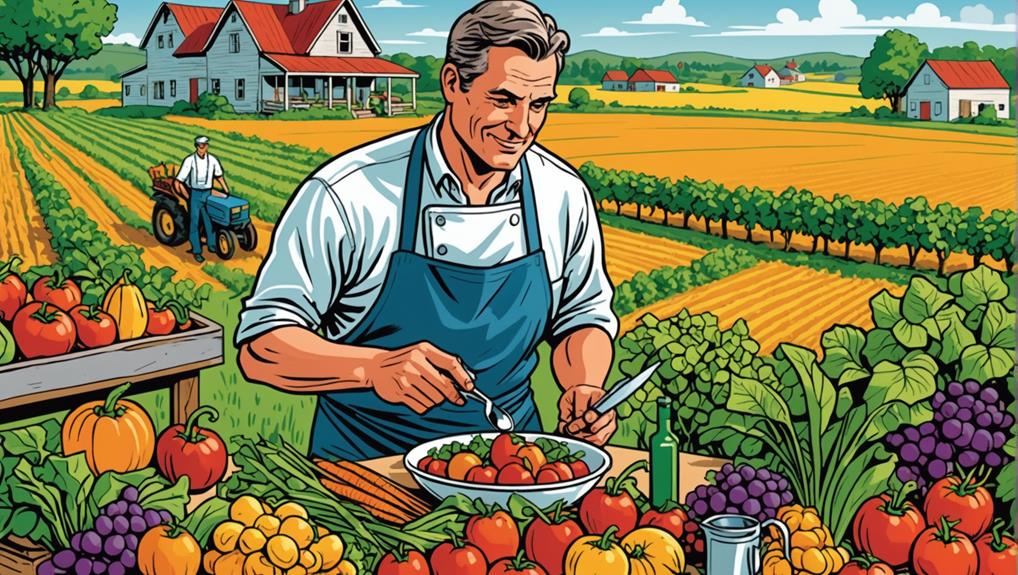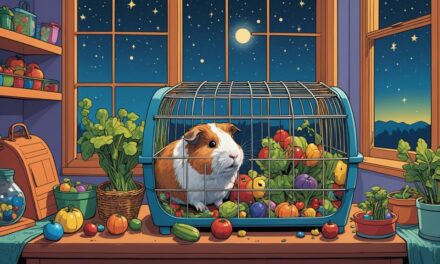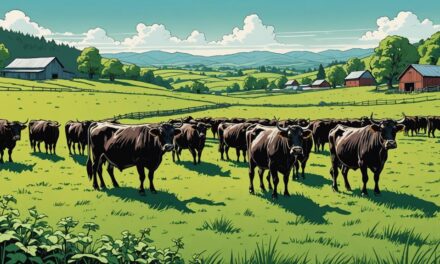Ever wondered if your apple's been on more flights than you? Check the food labels, they'll spill the beans about where it's from. For the detective types, traceability systems like the EU's TRACES are like the food version of Google Maps. Hit up farmers markets for local goodies, or find online platforms for fresh, local produce. Join food cooperatives to support your farm next door. Oh, and the USDA's got your back, ensuring quality on American farms. Trust me, once you start tracking, you'll never look at your plate the same way again. Curious to dig deeper? You're on the right track.
Main Points
- Read food labels for production details and state of origin to understand the source of your food.
- Use the mysterious codes on food packaging to access vital information about its origin and production.
- Purchase from farmers markets or food cooperatives to ensure traceability and support local agriculture.
- Utilize online platforms that offer farm-to-table experiences for transparency on food sourcing.
- Follow legislation and policies mandating food traceability for accurate and accountable information on food origins.
Reading Food Labels
When you're reading food labels, you'll find crucial details about where and how your food was produced. It's like a backstage pass to your dinner. Some companies even go the extra mile by disclosing the state of origin, giving you the lowdown on whether your apples are from Washington or your cornflakes are Nebraskan-born. This kind of transparency is a freedom-lover's dream, letting you make informed choices about what you eat.
Ever wonder why some brands shout about their origins while others play coy? It's all about trust. Imagine strolling through a farmers market, chatting with local growers. That's the vibe these labels are aiming for, making you feel like you're part of something real, not just another cog in the food industry's machine.
Federal programs, like USDA Foods, require U.S.-grown products to come with state of origin reports. Nebraska alone chipped in over 11.1 million pounds of food in 2020. That's a lot of corn!
Understanding Traceability
Traceability lets you know exactly where your food comes from and how it was produced, ensuring transparency and trust in what you eat. Imagine biting into an apple without wondering if it's a chemical cocktail. Traceability is your food's résumé, detailing every step from farm to table. It's like having GPS for your groceries, ensuring food safety and keeping the supply chain honest.
Ever wondered what those mysterious codes on your egg carton mean? They're not hieroglyphics; they're your ticket to knowing the farm, location, production date, and even if your eggs are organic. It's like speed dating but for breakfast.
Product traceability tracks your food's journey during production. Think of it as a backstage pass to the concert of your meal's life.
Input traceability, on the other hand, identifies the ingredients or materials used. It's like knowing the secret recipe of your grandma's famous cookies.
With traceability, you're not just a passive eater. You're an informed consumer, empowered to make better choices. So next time you take a bite, remember, you've got the power to know exactly what's on your plate and where it's been.
Legislation and Policies
Governments around the world have enacted legislation to ensure food traceability, protecting consumers and maintaining trust in the supply chain. Yeah, because nothing says 'I care about you' like a stack of paperwork.
The European Union, for instance, has its General Food Law, where food and feed businesses have to keep track of everything— who they got the food from, who they sold it to, what kind of food, when it got there, and sometimes, how much and how good it was.
In the U.S., you've got the USDA Foods program, which is all about making sure you know where your food is coming from, especially if it's locally produced. It's like having a backstage pass to your dinner plate. And, let's be honest, who doesn't want that?
The EU even has this fancy TRACES system to cut down on all the paperwork and make food traceability as easy as pie. Well, maybe not pie, but close enough.
These laws and systems are all about transparency and accountability, so you can sleep easy knowing your food didn't come from some sketchy place. Just remember, the next time you're munching on that locally produced carrot, there's a whole system making sure it's legit.
Buying From Farmers Markets
Buying from farmers markets gives you a direct connection to local farmers and the freshest produce available. Imagine yourself strolling through aisles of vibrant veggies, juicy fruits, and homemade goodies – it's like a treasure hunt, but tastier. You're not just buying food products; you're meeting the amazing folks who grew them. Those tomatoes? You can shake hands with the person who planted, watered, and picked them. Talk about farm-to-table!
Supporting farmers markets means you're helping to sustain your local community. It's like being a superhero, but instead of a cape, you've got a reusable grocery bag. Every dollar you spend keeps local agriculture alive and kicking. Plus, the food's fresher than anything you'll find in a supermarket. Seriously, those carrots probably just got pulled out of the ground this morning.
Many farmers markets are seasonal, so you get a rotating cast of deliciousness. One week it's strawberries, the next it's pumpkins. It's like nature's own variety show! And the best part? You can ask the farmers all kinds of questions – what's in season, how they grow their food, or even get cooking tips.
Online Direct Purchases
You can now order fresh, locally sourced produce and meats directly from farmers through their online platforms. It's like having your own secret farm, minus the early mornings and back-breaking work. These online platforms showcase a variety of locally sourced foods, so you can support your community and Know Where Your Food comes from without leaving your couch.
| Platform | What You Get |
|---|---|
| FarmFresh Online | Seasonal produce and meats |
| LocalHarvest | Organic veggies, dairy, and more |
| Rancher Direct | Grass-fed beef and pork |
| GreenMarket Goods | Sustainable seafood and poultry |
Imagine browsing through juicy tomatoes, fresh eggs, and tender steaks, all while wearing your PJs. Many farmers even share the history of their operations and farming methods. It's like a reality show, but with cows and corn.
Food Cooperatives
Food cooperatives offer a unique way to access locally grown products while supporting sustainable farming and community involvement. Think of it like a secret club, but instead of VIP access, you get fresh carrots and a say in what your local store stocks. Not too shabby, right?
Joining a food cooperative means you can bypass the usual grocery store drama and go straight to the source. You get top-notch, locally grown food products, and you're not just another faceless customer. Nope, you're part of the cool crew that helps decide what gets on the shelves. Want more kale or fewer pomegranates? Your voice actually matters here.
Plus, these cooperatives often double as mini-schools. They're all about teaching folks where their food comes from and why sustainable farming rocks. So, while you're munching on those organic apples, you can feel good about supporting local farmers and reducing your carbon footprint.
Whether it's a small, grassroots group or a big, established network, food cooperatives are like the Avengers of the food world—saving the planet, one locally grown tomato at a time. So, why not join in and give your grocery shopping a superhero upgrade?
USDA Foods Program
You're probably wondering if you can just waltz into the USDA Foods Program and grab some goodies, right?
Well, there's a bit more to it—like eligibility criteria and a food distribution process that's more organized than your mom's Tupperware cabinet.
And don't worry, they've got nutritional quality standards, so your school lunches won't just be mystery meat and sadness.
Program Eligibility Criteria
To participate in the USDA Foods program, organizations like food banks, schools, and emergency feeding groups must meet specific eligibility requirements. It's not a free-for-all buffet, folks. If you're part of the National School Lunch Program or The Emergency Food Assistance Program, you're in luck. These programs tap into the treasure trove that's USDA Foods, which procures over 200 types of food annually, totaling around $2 billion.
Imagine you're a school trying to make sure your students aren't surviving on a diet of mystery meat and neon-colored snacks. You'd need to prove you're part of a program like the National School Lunch Program. Or, if you're an emergency feeding group feeding families in crisis, you'd need to qualify under the Emergency Food Assistance Program.
Joining the USDA Foods program isn't just about filling bellies; it's about supporting local economies. Take Nebraska, for example—they contributed over 11.1 million pounds of food in 2020. That's a whole lot of corn and beef, my friends.
Food Distribution Process
Understanding how food gets from farms to your table in the USDA Foods program reveals a complex but efficient distribution process. Imagine a relay race, but with food instead of batons. The USDA procures over 200 types of food annually, spending around $2 billion. That's right, billions with a 'B'. These products don't just magically appear in your lunchroom or pantry; there's a whole army of people making it happen.
First, local farmers and producers in states like California, Minnesota, and Pennsylvania grow the food. Then, the USDA steps in and buys these products, supporting local economies. It's like a big group hug for farmers.
Next, the food gets shipped out to organizations such as food banks, schools, and emergency feeding groups. Your school lunch? Thank the USDA Foods program. That can of beans at the food bank? Yep, USDA again.
Nutritional Quality Standards
The USDA Foods program ensures the nutritional quality of its offerings by adhering to rigorous standards that prioritize health and well-being. Think of it as the food police, but with a friendlier vibe and cooler uniforms. They make sure your food comes from the best American farms, so you can track and trace that apple back to its tree.
Over 200 types of food are procured annually, supporting everything from your local school lunch to emergency feeding programs. Yep, when you bite into that apple, you're basically a detective.
States like California, Minnesota, and Pennsylvania are the top suppliers. Some foods are exclusive to certain states, like a secret club for produce.
Supporting Local Farmers
By purchasing from local farmers' markets and food cooperatives, you directly support small-scale farmers and contribute to sustainable agriculture. Think about it—you're not just buying food; you're investing in your community's future. Plus, who doesn't want to know where their tomatoes came from or the backstory of their beef?
Local farmers bring their freshest produce and meats straight from nearby farms to your neighborhood market. Imagine the taste of a tomato that was on the vine yesterday. It's like biting into freedom, bursting with flavor! And food cooperatives? They're like secret clubs where the password is 'locally grown.' Supporting local farmers through these channels helps them keep doing what they do best—growing awesome food.
Ever heard of Nebraska ranchers selling their beef, pork, and chicken online? It's like a farm-to-table experience without leaving your couch. These websites aren't just about sales; they spill the tea on livestock, farming practices, and even the farm's history. We're talking about livestock that munch on nutritious Nebraska corn.
Frequently Asked Questions
How Can I Verify the Authenticity of Organic Food Claims?
You wanna verify those organic claims? First, look for that fancy USDA Organic seal, it's like the VIP pass for food.
Check the label for the certifying agency and make sure it lists the percentage of organic stuff.
Oh, and remember, real organic food doesn't party with synthetic pesticides or GMOs.
If all else fails, channel your inner detective and Google the brand.
Happy munching!
What Technology Helps in Tracking the Origin of My Food?
Oh, you wanna know what tech is keeping tabs on your food? It's like an undercover spy operation!
You've got GPS systems, electronic chips, and tags on your veggies and steaks. Scanners and environmental sensors join the party, making sure your food's origin is no mystery.
All this data is stashed in online databases. So, next time you munch, you can trace that apple back to its roots, literally!
Are There Apps Available for Tracing Food Sources?
Well, you're in luck! When it comes to tracing food sources, there's an app for that. Actually, there are several.
HarvestMark and FoodLogiQ are like the Sherlock Holmes of your grocery list! Just scan a QR code, and boom, you know where your apple's been. It's like CSI: Produce Aisle.
You'll be supporting local farmers and making sure your food's as squeaky clean as your conscience.
How Can I Trace Imported Food Products?
So, you wanna trace imported food, huh? Easy peasy! Check the packaging for country of origin labels, they're like the food's birth certificate.
If you're still curious, ask the retailer—they're basically food detectives.
And for extra credit, snoop around on the FDA's Import Alerts website. It's like checking a food's criminal record.
Stay nosy, stay safe, and keep those taste buds happy!
What Are the Benefits of Knowing My Food's Origin?
Oh, you want to know where your food comes from? Shocking, right? Knowing your food's origin means you're not just a clueless consumer.
You get to support local farmers, boost the economy, and feel all warm and fuzzy inside. Plus, you'll sleep better knowing you're reducing your carbon footprint and making choices that match your values.
It's like being a food detective, but cooler.
Conclusion
So, tracking your food's journey isn't rocket science—it's more like detective work with snacks! Read those labels, visit farmers markets, buy online, and support local heroes (aka farmers).
With a bit of effort, you'll know if your apple took a trip around the world or just hopped from a nearby farm. Remember, every bite tells a story.
And hey, isn't it better to know your food's gossip than your neighbor's?
Happy munching!
















